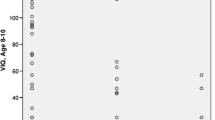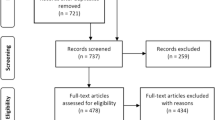Abstract
This study examined repetitive and stereotyped behaviors (RSB) in children with autism spectrum disorders (ASD, n = 50), developmental delays without ASD (DD; n = 25) and typical development (TD, n = 50) between 18 and 24 months of age. Children with ASD demonstrated significantly higher frequency and longer duration of RSB with objects, body, and sensory behaviors during a systematic behavior sample than both the DD and TD groups. RSB with objects were related to concurrent measures of symbolic capacity and social competence in the second year and predicted developmental outcomes as well as severity of autism symptoms at 3 years in children with communication delays. RSB in the second year appear to be important for early identification and prediction of developmental outcomes.
Similar content being viewed by others
References
American Psychiatric Association. (2000). Diagnostic and statistical manual of mental disorders (4th ed., text revision). Washington, DC: American Psychiatric Association.
Bakeman, R., & Gottman, J. M. (1997). Observing interaction: An introduction to sequential analysis (2nd ed.), New York: Cambridge University Press.
Bishop, S. L., Richler, J., & Lord, C. (2006). Association between restricted and repetitive behaviors and nonverbal IQ in children with autism spectrum disorders. Child Neuropsychology, 12, 247–267.
Bodfish, J. W., Symons, F. J., Parker D. E., & Lewis, M. H. (2000). Varieties of repetitive behavior in autism: comparisons to mental retardation. Journal of Autism and Developmental Disorders, 30, 237–243.
Bopp, K. D., Mirenda, P., & Smith, V. (2005, November). Predictors of outcomes for children with autism receiving early intervention. Paper presented at the annual American Speech, Language, and Hearing Association (ASHA) convention, San Diego, CA.
Bruckner, C. T., & Yoder, P. (2006). Interpreting kappa in observational research: Baserate matters. American Journal on Mental Retardation, 111, 433–441.
Charman, T., & Swettenham, J. (2001). Repetitive behaviors and social-communicative impairment in autism: Implications for developmental theory and diagnosis. In J. A. Burack, T. Charman, N. Yirmiya, & P. R. Zelazo (Eds.), The development of autism: Perspectives from theory and research (pp. 325–345). New Jersey: Lawrence Erlbaum Associates.
Charman, T., Taylor, E., Drew, A., Cockerill, H., Brown, J., & Baird, G. (2005). Outcome at 7 years of children diagnosed with autism at age 2: Predictive validity of assessments conducted at 2 and 3 years of age and pattern of symptom change over time. Journal of Child Psychology and Psychiatry, 46, 500–513.
Cohen, J. (1960). Coefficient of agreement for nominal scales. Educational and Psychological Measurement, 20, 37–46.
Cohen, J. (1988). Statistical power analyses for the behavioral sciences (2nd ed.), Hillsdale, NJ: Lawrence Erlbaum Associates.
Cox, A., Klein, K., Charman, T., Baird, G., Baron-Cohen, S., Swettenham, J., Wheelright, S., & Drew, A. (1999). Autism spectrum disorders at 20 and 42 months of age: stability of clinical and ADI-R diagnosis. Journal of Child Psychology and Psychiatry, 40, 719–732.
Cuccaro, M. L., Shao, Y., Grubber, J., Slifer, M., Wolpert, C. M., Donnelly, S. L., et al. (2003). Factor analysis of restricted and repetitive behaviors in autism using the Autism Diagnostic Interview-R. Child Psychiatry and Human Development, 34, 3–17.
Einfeld, S. L., & Tonge, B. J. (2002). Manual for the developmental behavioural checklist: Primary career version (DBC-P) and teacher version (DBC-T) (2nd ed.). Melbourne: University of New South Wales and Monash University.
Evans, D. W., Leckman, J. F., Carter, A., Reznick, J. S., Henshaw, D., King, R. A., & Pauls, D. (1997). Ritual, habit, and perfectionism: The prevalence and development of compulsive-like behavior in normal young children. Child Development, 68, 58–68.
Fleiss, J. S. (1981). Statistical methods for rates and proportions. New York: Wiley.
Gardenier, N., MacDonald, R., & Green, G. (2004). Comparison of direct observational methods for measuring stereotypic behavior in children with autism spectrum disorders. Research in Developmental Disabilities, 25, 99–118.
Gotham, K., Risi, S., Pickles, A., & Lord, C. (2007). The autism diagnostic observation schedule: Revised algorithms for improved diagnostic validity. Journal of Autism and Developmental Disorders, 37, 613–627.
Honey, E., McConachie, H., Randle, V., Shearer, H. & Le Couteur, A. (in press). One-year change in repetitive behaviours in young children with communication disorders including autism. Journal of Autism and Developmental Disorders. doi:10.1007/s10803-006-0191-1
Kanner, L. (1943). Autistic disturbances of affective contact. Nervous Child, 2, 217–250.
Krug, D., Arick, J., & Almond, P. (1979). Autism screening instrument for educational planning: Background and development. In J. Gilliam (Ed.), Autism: Diagnosis, instruction, management and research. Austin: University of Texas Press.
Lewis, M. H., & Bodfish, J. W. (1998). Repetitive behavior disorders in autism. Mental Retardation and Developmental Disabilities, 4, 80–89.
Lord, C. (1995). Follow-up of 2 year-olds referred for possible autism. Journal of Child Psychology and Psychiatry, 36, 1365–1382.
Lord, C., Rutter, M., & LeCouteur, A. (1994). Autism diagnostic interview-revised: A revised version of a diagnostic interview for caregivers of individuals with possible pervasive developmental disorder. Journal of Autism and Developmental Disorders, 24, 659–685.
Lord, C., & Pickles, A. (1996). Language level and nonverbal social-communicative behaviors in autistic and language-delayed children. Journal of the American Academy of Child and Adolescent Psychiatry, 35, 1542–1550.
Lord, C., Rutter, M., DiLavore, P., & Risi, S. (2002). Autism diagnostic observation schedule. ADOS manual. Los Angeles: Western Psychological Services.
McCathren, R. B., Yoder, P. J., & Warren, S. F. (2000). Testing predictive validity of the communication composite of the communication and symbolic behavior scales. Journal of Early Intervention, 23, 36–46.
McWilliam, R. A., & Ware, W. B. (1994). The reliability of observations of young children’s engagement: An application of generalizability theory. Journal of Early Intervention, 18, 34–47.
Mervis, C. B., & Klein-Tasman, B. P. (2004). Methodological issues in group-matching designs: levels for control variable comparisons and measurement characteristics of control and target variables. Journal of Autism and Developmental Disorders, 34, 7–17.
Mitchell, S. K. (1979). Interobserver agreement, reliability, and generalizability of data collected in observational studies. Psychological Bulletin, 86, 376–390.
Mooney, E. L., Gray, K. M., & Tonge, B. J. (2006). Early features of autism: Repetitive behaviours in young children. European Child and Adolescent Psychiatry, 15, 12–18.
Moore, V., & Goodson, S. (2003). How well does early diagnosis of autism stand the test of time? Autism, 7, 47–63.
Mundy, P., Sigman, M., & Kasari, C. (1994). Joint attention, developmental level, and symptom presentation in autism. Development and Psychopathology, 6, 389–401.
Mullen, E. (1995). The Mullen scales of early learning. Circle Pines, MN: American Guidance.
Schopler, E., Reichler, R. J., Bashford, A., Lansing, M. D., & Marcus, L. M. (1990). Individualized assessment and treatment for autistic and developmental disabled children—Volume 1: Psychoeducational Profile-Revised (PEP-R) (Vol. 1). Texas: ProEd.
Sparrow, S., Balla, D., & Cicchetti, D. (1984). Vineland adaptive behavior scales. Circle Pines, MN: American Guidance Service.
Stone, W. L., Lee, E., Ashford, L., Brissie, J., Hepburn, S., Coonrod, E., & Weiss, B. (1999). Can autism be diagnosed accurately in children under 3 years? Journal of Child Psychology and Psychiatry, 40, 219–226.
Symons, F. J., Sperry, L. A., Dropik, P. L., & Bodfish, J. W. (2005). The early development of stereotypy and self-injury: A review of research methods. Journal of Intellectual Disability Research, 49, 144–158.
Thelen, E. (1979). Rhythmical stereotypies in normal human infants. Animal Behaviour, 27, 699–715.
Thelen, E. (1981). Kicking, rocking, and waving: Contextual analysis of rhythmical stereotypies in normal human infants. Animal Behaviour, 29, 3–11.
Turner, M. (1999). Annotation: Repetitive behavior in autism: A review of psychological research. Journal of Child Psychology and Psychiatry, 40, 839–849.
Werner, E., & Dawson, G. (2005). Validation of the phenomenon of autistic regression using home videotapes. Archives of General Psychiatry, 62, 889–895.
Werner, E., Dawson, G., Munson, J., & Osterling, J. (2005). Variation in early developmental course in autism and its relations with behavioral outcome at 3–4 years of age. Journal of Autism and Developmental Disorders, 35, 337–350.
Wetherby, A. M., Allen, L., Cleary, J., Kublin, K., & Goldstein, H. (2002). Validity and reliability of the communication and symbolic behavior scales developmental profile with very young children. Journal of Speech, Language and Hearing Research, 45, 1202–1218.
Wetherby, A., Goldstein, H., Cleary, J., Allen, L., & Kublin, K. (2003). Early identification of children with communication disorders. Concurrent and predictive validity of the CSBS Developmental Profile. Infants and Young Children, 16, 161–174.
Wetherby, A., & Prizant, B. (2002). Communication and symbolic behavior scales developmental profile—First normed edition. Baltimore, MD: Paul H. Brookes.
Wetherby, A., Watt, N., Morgan, L., & Shumway, S. (2007). Social communication profiles of children with autism spectrum disorders late in the second year of life. Journal of Autism and Developmental Disorders, 37, 960–975.
Wetherby, A., & Woods, J. (2002). Systematic observation of red flags for autism spectrum disorders. Unpublished manual, Florida State University, Tallahassee, FL.
Wetherby, A. M., Woods, J., Allen, L., Cleary, J., Dickenson, H., & Lord, C. (2004). Early indicators of autism spectrum disorders in the second year of life. Journal of Autism and Developmental Disorders, 34, 473–493.
Acknowledgment
This research was supported in part by a grant from the National Institutes of Health, National Institute on Deafness and Other Communication Disorders (R01DC007462) and a grant from the U.S. Department of Education, Office of Special Education and Rehabilitation Services (H324C030112). The contents of this manuscript are solely the responsibility of the authors and do not necessarily represent the official views of the NIH or USDOE. The authors would like to thank the families who gave their time to participate in this project.
Author information
Authors and Affiliations
Corresponding author
Rights and permissions
About this article
Cite this article
Watt, N., Wetherby, A.M., Barber, A. et al. Repetitive and Stereotyped Behaviors in Children with Autism Spectrum Disorders in the Second Year of Life. J Autism Dev Disord 38, 1518–1533 (2008). https://doi.org/10.1007/s10803-007-0532-8
Received:
Accepted:
Published:
Issue Date:
DOI: https://doi.org/10.1007/s10803-007-0532-8




